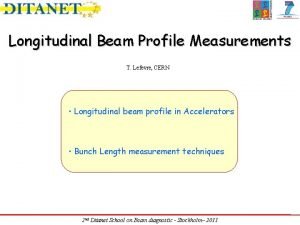Section 2 Types of longitudinal studies From the






- Slides: 6

Section 2: Types of longitudinal studies From the CLOSER Learning Hub Module: Introduction to longitudinal studies

Panel studies • Follow the same individuals over time and vary considerably in scope and scale • Household panel studies collect information from the whole household, rather than individuals • Household panels incorporate new participants as households break-up and reform

Cohort studies • Follow groups of individuals with specific temporal boundaries • Birth cohort studies which follow groups of people born within the same time period • Cohort studies represent a particular cohort of people, rather than the population as a whole

Record linkage studies • Conducted without personal interviews by linking administrative records (for example, benefit receipts or census records) for the same individuals over time • Advantages: potentially large sample sizes, less risk of participant drop out or reporting error • Disadvantages: limited by the nature of the records they are based on • Example: UK Census Longitudinal Studies

Prospective vs retrospective studies Prospective studies collect data about their participants as their characteristics or circumstances change. • Example: British birth cohort studies Retrospective studies collect information about participants’ pasts, either through recall questions or linking historic records. • Example: Hertfordshire Cohort Study

Longitudinal vs cross-sectional studies Cross-sectional Longitudinal One point in time Several points in time Different samples Same sample Snapshot of a given point in time, change at a societal level Change at the individual level Ex. British Social Attitudes Survey, Labour Force Survey Ex. British Birth Cohort Studies, Understanding Society











